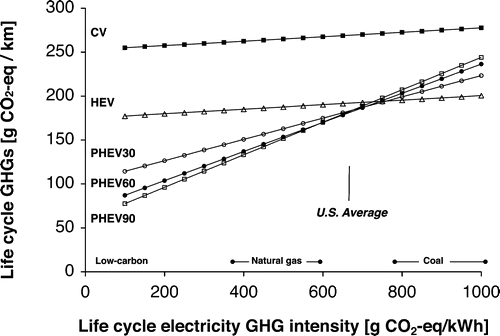Let me use your numbers and follow 1000 units of chemical energy input being converted to energy for turning the car's drive shaft:
A power plant, 35% efficient, gives 650 electrical Units of Energy (UEs, here after) from the 1000 UE of chemical energy input.
After reaching the location of the battery the 93% efficient grid has 650x0.93 = 604.5 UE available for charging the battery.
95% battery charging efficiency produces chemical energy in the battery of 604.5x0.95=574.23 UE. {I will neglect the self discharge loss while car is parked.}
Also 95% efficiency for battery chemical energy converted to battery output electrical energy is 545.56 UE supplied to the electric motor.
Which in a 90% efficient electric motor gives 491 UE in the turning drive shaft of the car.
Thus the initial 1000 units of chemical (typically in coal) is converted into drive shaft energy with 49.1% overall efficiency in the EV system.
Now you said the ICE was 25% efficient so it gives 250 EUs when consuming 1000 EUs of chemical energy (in gasoline).
Thus to get the same energy to the wheels, say 100 EUs, the gasoline chemical energy required is 400 EUs and the coal chemical energy required for the EV system is 203.66 EU. However, the CO2 production from burning 203 UE of coal is worse than burning 400UE of gasoline as only carbon is being oxidized when coal is burned.
Calling gasoline iso-octane, (C8H18) we oxidize 18 hydrogen atoms to water for every 8 of CO2 produced. I am too lazy to look up the binding energy, of all the hydro-carbons in gasoline so will just guess that burning the same chemical energy in coal produces twice as much CO2 as burning that amount of chemical energy in gasoline. This is the same reason natural gas produces so much less CO2 for the same energy release than coal. I.e. natural gas burns 4 hydrogen for every carbon burned. My guess is based on fact that oxygen takes 16 electrons from carbon but 18 electrons from hydrogen when octane is burned. This crude analysis tends to say the more than half of the energy released by burning gasoline comes from forming water and less than half from forming CO2. If that is true then burning 400 UE of gasoline may produce slightly less CO2 than burning 203 UE of coal.
That is why I do doubt your reference’s claim that the CO2 production with EV is 17 to 22% less, even with coal as the primary energy source for charging the battery. That claim put out by: "The Electric Vehicle Discussion List, founded in 1991 by
EV enthusiast Clyde Visser PE" This quote from their home page at:
www.evdl.org/
I suspect he has strong bias in favor of the EV.
See right there, nothing more to argue about. But strangely you ignore your own citation and argue every little point as if it didn't just tell you that even with coal an EV would produce less CO2.
No, I did not "ignore the reference's claim" that the EV produces 17 to 22% less CO2, I just don’t believe it is likely to be true based on the above.
Another point in gasoline car’s favor is the high volumetric and specific energy densities of gasoline.
ENERGY DENSITY COMPARISONS (From:
http://www.tinaja.com/glib/energfun.pdf )
Gasoline .... 9000 Wh/l ...13,500 Wh/Kg
LNG ......... 7216 Wh/l ...12,100 Wh/Kg
Propane .... 6600 Wh/l ...13,900 Wh/Kg
Ethanol ..... 6100 WH/l ...7,850 Wh/Kg
Liquid H2....2600 Wh/l ...39,000* Wh/Kg
150 Bar H2. 405 WH/l ....39,000* Wh/Kg
Lithium ..... 250 Wh/l ....350 Wh/Kg
Flywheel ... 210 Wh/l ....120 Wh/Kg
Liquid N2 ... 65 Wh/l ..... 55 Wh/Kg
Lead Acid .. 40 Wh/l ..... 25 Wh/Kg
Compr Air .. 17 Wh/l ..... 34 Wh/Kg
STP H2 ......2.7 Wh/l ....39,000* Wh/Kg
*=uncontained
I.e. much lower when weight of steel tank etc is included or in the case of STP H2, the tank is bigger than the car for useful range. You would need legal permits to tow H2 tank behind the car.
The energy volume density of gasoline over Li-ion battery is 9000/250 = 36 times and that does not include the thin walled gas tank or the thicker walled battery cases and much heavier system attaching the batteries below floor boards.
The energy weight density of gasoline over Li-ion battery is 13,500/55 =245.5
That is because gasoline floats on water but most Li-ion batteries sink fast in water - like a rock. Note also that this weight is still being hauled around when the car is running on the hybrid gasoline generator.
But of course the main reason EVs will not be popular is their high cost, even with subsidies, which will phase out. (If not killed first by typical voters who grow tired of subsidizing the typically quite rich buyer of an EV.)
I don't think there are many advocates of the hydrogen fuel still left (unless very ignorant) but it is interesting to note that a gallon of either gasoline or ammonia contains significantly more H2 than a gallon of liquid hydrogen, which must be very cold to be liquid.


